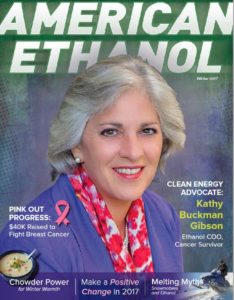Category: Conservation

Want to Combat Fake News? Become a Better Researcher
Finding information in our digital world has never been easier, but there’s a dark side. Fake news seems to lurk everywhere, wielding the power to misinform and mislead.
How do you get closer to the truth? I asked Pati Daisy, a retired teacher-librarian from my hometown of Lake City, Iowa, to share her expertise. Here’s to keepin’ it real.
I know it takes time to research properly. Why is it valuable to invest the time?
It forces a person to slow down, think for a bit, and ask is the statement in question is a fact, opinion, myth or some blend of the three. Also, question the hidden agenda behind the statement’s presenter(s). What is the stated or unstated bias? What is the goal behind the statement? Who is the intended audience? How is that audience being manipulated?
What are the top 2 or 3 things that drive you crazy when it comes to people failing to research properly?
The thing that disturbs me the most is not that people fail to research properly as much as they fail to research at all. I will lay that blame squarely on a failure of our education system.
Here’s where is gets personal. I am a librarian. I ended my career as a teacher-librarian, but early in my career, librarians were not really seen as teachers as much as selectors and dispensers of information. We were taught how to evaluate, select and maintain information sources that would support a school curriculum. Publishers had editors whose role was to verify or at least help to ensure what was published was authoritative and useful to the intended audience. After all, there is considerable investment in publishing a book.
For a long time, this system was good enough. One person in a school or school district who knew how to do that was good enough. As long as carefully selected information sources were made available to educators and students alike, people really didn’t have to do much authentic re-search. But this is no longer the case. I believe there is not nearly enough being done in our schools to help staff and students learn and be held accountable for those skills.
Students will go to Wikipedia and the first results from Google if they are allowed to do so. It’s just so easy. Teachers today should maybe not accept those things as legitimate resources without some restrictions.
That being said, the Wikipedia of today is vastly improved over its beginnings. I would advise students, staff and general public to start there. It’s a good place to get a general overview or an outline of a topic. I would not allow Wikipedia articles as a source for a student research paper, however, but people can often find out the questions they didn’t even know to ask. Furthermore, Wikipedia now often lists a great number of sources to support their articles. Students and even the general public may well want to start there.
As for the first few Google hits, there are probably whole college courses on how to manipulate search engines, how some sites pay to be higher on the results list, and how sites are constructed so that the search brings the site higher in the results list. Suffice it to say, there’s no inter-net help-desk librarian sitting there answering your question. Search engines like Google are computer programs that have been carefully created (by humans) to specifically bring certain websites up first.
Many people say they don’t know how to combat fake news, because they don’t know where to go for information they can trust. Any advice on how people can sort fact from fiction?
I don’t know that the average person can truly combat fake news. but they can learn more about news and media sites. There are a couple of media bias charts that will help people to recognize the potential bias of particular new/media organizations.
Two that I recommend All Sides Media Bias Chart and Ad Fonets Inter-active Media Bias Chart.
One of my favorite quotes is from Mark Twain, who said “It’s better to remain silent and thought a fool than to open your mouth and remove all doubt.” Did Twain really say this? Upon further research I find that this saying (or a similar wording) has been attributed to Twain, Abraham Lincoln, Samuel Johnson, and the Book of Proverbs, among others. An unskilled researcher runs the risk of falling down the proverbial rabbit hole when trying to verify something. It’s difficult, and far too many haven’t been taught how to do it.
 My best advice is to always question the source.
My best advice is to always question the source.
There are several things to look for when trying to determine the veracity of a source. When I taught information skills I used the mnemonic RAD-CAB™ which teaches you to consider these six key points:
1. Relevance
2. Appropriateness
3. Detail
4. Currency
5. Authority
6. Bias
Another mnemonic is called The CRAAP Test (I know, don’t you just love that?) The researcher is asked to consider:
• Currency
• Relevance
• Authority
• Accuracy
• Purpose
As you evaluate sources, start with the basics.
1. Learn how to read the URL. For example, is it a:
– .com – a commercial site, trying to sell
– .edu – from an educational institution, trying to inform
– .org – an organization, trying to persuade
– .gov – government
– .mil – military
– Country designation: .uk – United Kingdom, .il – Israel, .ru – Russia, .no – Norway, and so on
2. Consider the source. My pet peeve is satire sites. Don’t get me wrong, I love satire, but satire is currently being used to inflame emotions. Those sites cater to the gullible, eliciting an immediate gut reaction of outrage. Too often, an outraged reader will then share the site or story, and others become inflamed. That immediate sense of outrage should be followed by these questions Really? Is this true? Who says?
You can try to answer those questions by:
– Going to the website home page and looking for the About Us page. This is something I nearly always do before I even think about re-posting something. I want to know who originally posted it and what their purpose is. The About Us section is usually located in very small letters at the very bottom of the webpage. It is often rather hard to find, by design, I might add. If it is not there, that should be your first red flag.
– Find out who is the author or group behind the page.
– Find out what their credentials are. What gives them authority in the particular subject they are presenting?
– Above all, try to determine the intention, purpose, bias and point of view of the site.
Since researching could be an never-ending process, if you let it, how you do draw the line?
The decision to stop researching depends greatly on your purpose. Are you simply looking for some quick fix, some validation of your strongly held opinion? Or are you verifying a statement or idea for its accuracy? Are you truly seeking to further and more deeply understand a statement, idea, concept, etc.? Are you seeking to learn if there is another viewpoint on that topic?
What’s your advice about analyzing bias when researching?
It has been often said that the pen is mightier than the sword. I believe that is true. Swords, guns, weapons of war do one thing and do it well. They kill, and whoever kills the most wins. The pen or words, if you will, can be subtly woven, bent, twisted and manipulated with the sole purpose of influencing the reader/listener/viewer. Words have power. Just as responsible gun owners learn and practice proper gun safety, so should we all learn and practice proper evaluation of any information we consume. We need to always be aware that there is the potential for bias in everything we hear, read or see.
Every human being has some type of bias, but just because we may believe something does not make it true. We need to question, always.
Keep in mind:
– Political viewpoint
– Purpose – such as to inform, persuade or sell
– Who is financially supporting the publication or website?
– How is the opposing view of the topic handled?
Does the author or site:
– Use extreme all-or-nothing type words?
– Use words that appeal to emotion?
– Use words that oversimplify or generalize?
– Present a limited view?
– Cite the sources used?
The New Jersey Institute of Technology has a very good explanation of things you should keep in mind as you check for bias. Click here for details.
Anything else you’d like to add about how to research properly?
The admonition “let the buyer beware” has never been more crucial.
My final word is to remember that anyone can produce and post anything on the internet now. There is no “librarian in the sky” skillfully evaluating and selecting information for us. We have to do that important job ourselves.
It’s too easy not to, but it’s so important that we must. We must learn, we must question, and we must think.
Want more?
I invite you to read more of my blog posts if you value intriguing Iowa stories and history, along with Iowa food, agriculture updates, recipes and tips to make you a better communicator.
If you’re hungry for more stories of Iowa history, check out my top-selling “Culinary History of Iowa: Sweet Corn, Pork Tenderloins, Maid-Rites and More” book from The History Press. Also take a look at my other books, including “Iowa Agriculture: A History of Farming, Family and Food” from The History Press, “Dallas County” and “Calhoun County” book from Arcadia Publishing. All are filled with vintage photos and compelling stories that showcase the history of small-town and rural Iowa. Click here to order your signed copies today! Iowa postcards are available in my online store, too.
If you like what you see and want to be notified when I post new stories, be sure to click on the “subscribe to blog updates/newsletter” button at the top of this page, or click here. Feel free to share this with friends and colleagues who might be interested, too.
Also, if you or someone you know could use my writing services (I’m not only Iowa’s storyteller, but a professionally-trained journalist with 20 years of experience), let’s talk. I work with businesses and organizations within Iowa and across the country to unleash the power of great storytelling to define their brand and connect with their audience through clear, compelling blog posts, articles, news releases, feature stories, newsletter articles, social media, video scripts, and photography. Learn more at www.darcymaulsby.com, or e-mail me at yettergirl@yahoo.com.
Let’s stay in touch. I’m at darcy@darcymaulsby.com, and yettergirl@yahoo.com.
Talk to you soon!
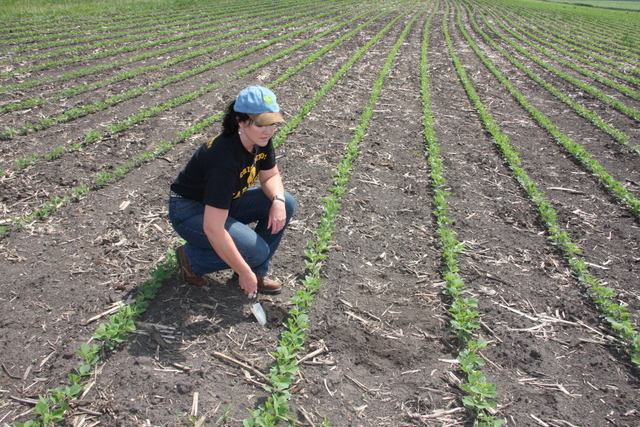
Learning from the Land: 9 Surprising Ways Farmers Make Conservation a Priority
Spring planting will soon arrive here in Iowa, but planting our Calhoun County fields isn’t the only thing on my mind. My family is always looking for ways to embrace conservation and better manage our land, because we understand the benefits of improved water quality and soil sustainability extend far beyond our fields.
This mindset defines any true steward of the land, and Iowa is blessed with an abundance of conservation-minded farmers. This is reflected in the Iowa Environmental Leader Award, which recognizes the exemplary voluntary efforts of Iowa’s farmers who are committed to healthy soils and improved water quality.
We were honored to receive a 2016 Iowa Environmental Leader Award last August at the Iowa State Fair from Iowa’s governor, lieutenant governor, Iowa Department of Agriculture and Land Stewardship staff and Iowa Department of Natural Resources staff. It was inspiring to see how many other progressive, dedicated farm families across Iowa are redefining the sustainable nature of modern agriculture.
Learning from the land is just part of my DNA. My great-great grandfather, John Dougherty, emigrated from Ireland and settled in Calhoun County north of Lake City in 1889. He purchased 200 acres, and history records that he “placed the land under a high state of cultivation,” a legacy my family carries on today with our Century Farm.
I’m also guided by the philosophy of another Iowan, Aldo Leopold, whose “land ethic” called for a principled, caring relationship with nature. “When we see land as a community to which we belong, we may begin to use it with love and respect,” noted Leopold, author of the Sand County Almanac.
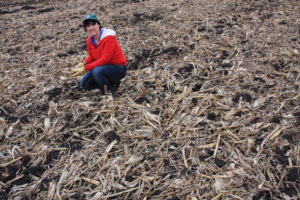
The residue of the previous year’s crop helps hold our precious soil in place and builds organic matter in the soil.
Here are 9 ways that Iowa farm families like mine are putting this land ethic into practice:
1. Building on a legacy of conservation. Iowa agriculture reflects a long history of people helping the land. The process accelerated in 1935, when the Soil Conservation Service was created in the U.S. Department of Agriculture. In this era, young men with the Civilian Conservation Corps (CCC) worked on hundreds of Iowa farms to assist with soil-erosion-control projects, such as terracing hills, digging ponds, repairing gullies and planting trees for wind breaks. In 1948, more than 100,000 farmers from across the Midwest flocked to the National Soil Conservation Field Days in Dexter, Iowa, to learn new conservation practices. Even President Harry Truman made an appearance see farmers’ conservation efforts first-hand. (You can read more about it in my blog post “Riding with Harry,” where I interviewed a young Iowan who escorted Truman on a bulldozer in the fields.) While much has changed in farming since the 1930s and 1940s, one thing endures—our commitment to be good stewards of the land and keep our land productive for generations to come.
2. Prioritizing soil health. I’m convinced that unlocking the secrets of the soil is the next frontier in farming. As world population and food production demands rise, keeping our soil healthy and productive is of paramount importance. By using cover crops, diverse rotations and other systems, more Iowa farmers are increasing their soil’s organic matter while improving microbial activity. As a result, farmers are increasing water infiltration, controlling runoff and enhancing soil health—all while harvesting better yield and profit potential.
3. Balancing the three-legged stool of sustainability. Successful farm management involves environmental sustainability, economic sustainability and social sustainability that benefits not only our farm, but our community, state and beyond. Without all of those three legs, the sustainability stool falls down. That’s why my family has invested in a number of best-management practices, including soil testing to better manage fertilizer applications, grassed waterways and grassed field borders to help control soil erosion, conservation tillage, drainage water management, and the addition of windbreaks and shelterbelts. These practices help improve soil health, prevent erosion, boost yield potential and keep nutrients in place where they can nourish our crop and protect Iowa’s water quality.
4. Learning from others. I’m blessed to live in the epicenter of agriculture, where farmers have a strong support network to help enhance their conservation and farm management strategies. I value input from Iowa State University Extension, Iowa Farm Bureau Federation, Iowa Soybean Association, Iowa Corn Growers Association, MaxYield Cooperative’s SciMax Solutions, Natural Resources Conservation Service, Practical Farmers of Iowa and other trusted organizations. In my roles as a freelance ag journalist and president of the Calhoun County Farm Bureau and Calhoun County Corn Growers, I enjoy meeting with other conservation-minded farmers across the state who are willing to question current management practices and never stop asking, “Is there a better way?”
5. Finding conservation-minded urban partners. As Iowans, we’re all in this together when it comes to conservation. I applaud the City of Storm Lake for its city-wide plan emphasizing green infrastructure practices. These practices include bioreactors, which essentially function like large “coffee filters” to help improve water quality. The results are impressive. City manager Jim Patrick tells me that Storm Lake has seen a bioreactor remove 45 percent of the nitrates coming off agricultural land in the area. Storm Lake has also hosted “reverse field days” so farmers, soil and water conservation groups and others can see the progress that’s being made. “These partnerships are vital, because rural and urban communities are in this together,” Patrick told me. “It’s not city water or ag water; it’s all our water.”
6. Focusing on continuous improvement. A spirit of continuous improvement contributes to long-term success in any business, including our farm. My dad, Jim Dougherty, served as a township committee member with the Agricultural Stabilization and Conservation Service, the forerunner of USDA’s Natural Resources Conservation Service. Dad was also quick to see the value of conservation tillage and other practices that make the farm productive and sustainable. Today, we are using precision ag tools to maximize production and conservation. We never stop seeking solutions.
7. Developing a conservation philosophy. If you never try something different, how do you know if you’re maximizing your investment on every acre? My conservation philosophy is to keep learning, help my family do our best to protect Iowa’s precious soil and water resources, and pass on a legacy of conservation to future generations.
8. Providing leadership. We’ve hosted numerous media professionals at our farm, from the local newspaper to USA Today and “Market to Market,” to share what we’re doing to promote conservation and protect soil and water quality. In 2015, I also worked with the Iowa Food and Family Project to coordinate and host Expedition Yetter, a bus tour of farms in west-central Iowa that allowed urban Iowans to see conservation in action. (Watch “Market to Market’s” Expedition Yetter and water quality video here.) That same year, I also testified before the U.S. Senate Small Business Committee in Washington, D.C. to explain to federal lawmakers how conservation plays a key role on my family’s farm.
9. Enjoying the journey. Enhanced conservation, like improved farm management, is a quest that never ends. I value the legacy of farmland that was passed on to my family from previous generations and enjoy the challenge of maximizing our acres. With all the technology available today, it’s exciting to see what’s next as we keep learning from the land to enhance the sustainable nature of modern agriculture.
Darcy Dougherty Maulsby is a proud member of a Century Farm family, author, entrepreneur, business owner, and farm leader from Lake City. Visit her online at www.darcymaulsby.com.
* This editorial first appeared in the April 9, 2017, Sunday edition of the Fort Dodge Messenger.
P.S. Thanks for joining me. I’m glad you’re here.
@Copyright 2017 Darcy Maulsby & Co.
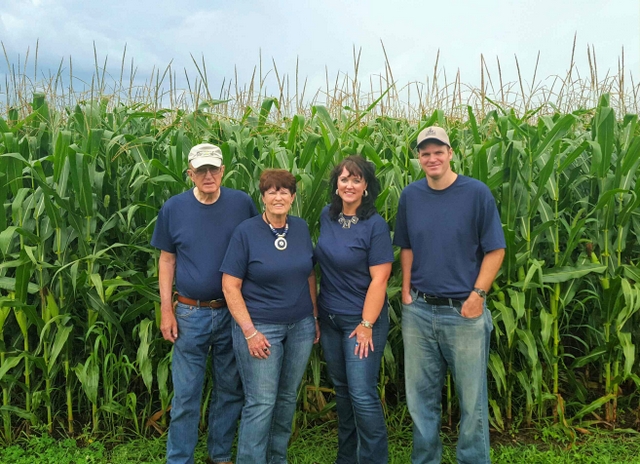
My family (including my dad, Jim, my mom, Jan, me and my younger brother, Jason, on our Calhoun County Century Farm.
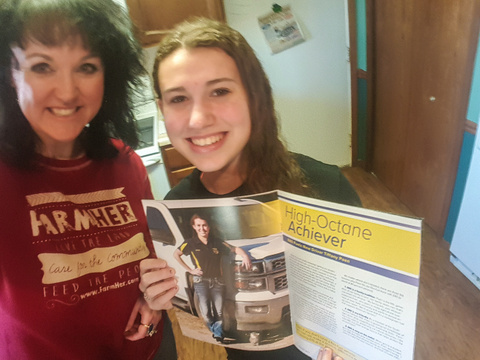
High-Octane Achiever: Ethanol Fuels New Driver Tiffany Poen
Most of us can vividly remember getting our driver’s license and our first car—our first taste of independence and grown-up responsibility. Fuzzier, however, is our first solo trip to fill up at the pump and the likely confusing choice we made purchasing gas. Not for Tiffany Poen, a new driver (and my awesome neighbor!) who is deliberate with her fuel choice.
Ethanol fuels her new adventure and, just like the truck she inherited from her grandfather, the choice was a matter of passing down a family tradition.
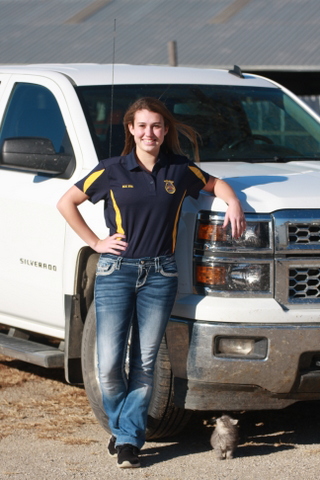
Tiffany Poen from Lake City, Iowa, is a proud South Central Calhoun FFA member and ethanol supporter.
“I really looked forward to getting my license and inheriting my grandpa Bob’s truck,” said Poen, 17, a high school junior from Lake City, Iowa. “This truck is special because my grandma Betty used to ride in it before she passed away in 2013 from complications of cancer.”
Family is important to Poen, who credits her grandfather, mom, and dad for teaching her to drive on the gravel roads near her family’s farm. After completing a driver’s education course, Poen was excited to receive her official driver’s license, which has opened up a new world of possibilities.
“I can go where I want,” said Poen, a high school basketball cheerleader and dancer who drives to practices at the local dance studio and joins friends at the community-owned movie theater where she volunteers.
No matter where she’s headed, there are three big reasons why Poen fills her flex-fuel truck with E85 (a blend of 85 percent ethanol):
1. E85 is a family tradition. Poen is the fifth generation of her family to farm. Her family raises corn that’s converted into ethanol. “My family only uses ethanol,” explained Poen, who plans to study agricultural business at Iowa State University and wants to pursue an ag sales career. “We’re proud that it’s a homegrown fuel that supports America’s farmers.”
2. E85 is eco-friendly. As a member of the South Central Calhoun FFA, Poen is growing her knowledge of agriculture while expanding her leadership skills. “Farming is focused on preserving our natural resources. I like how E85 is a clean energy source that helps protect the environment.”
3. E85 is easy on the wallet. When you’re a student, you have to make your money count. Poen appreciates how E85 and other ethanol blends are budget-friendly. “I want to make the best choices, and that includes E85.”
It was so much fun to interview Tiffany for this article, which appeared in the Winter 2017 issue of American Ethanol magazine, which is distributed nationwide. As you can see, even one of the Poen’s kittens got in on the act!
P.S. Thanks for joining me. I’m glad you’re here.
@Copyright 2017 Darcy Maulsby & Co.
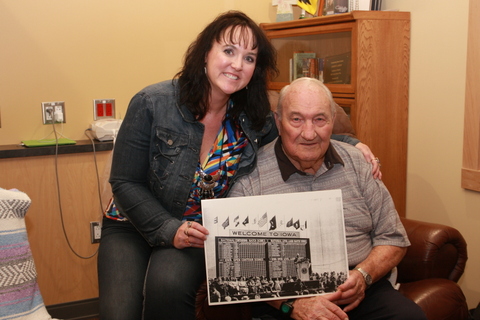
Riding with Harry: 2016 Presidential Election Reflects Truman’s Iowa Revival at 1948 Plowing Match in Dexter
Unpredictable. Shocking. Historic. All have been used to describe the 2016 presidential election, but they also characterized the remarkable presidential election of 1948. Back then, no one thought Harry Truman had any chance of returning to the White House, although he accomplished one of the biggest upsets in U.S. presidential history—and it all started on a farm near Dexter, Iowa.
Bob Larson, an 18-year-old farm boy from Casey, saw it all. “Harry Truman was a farmer, not a politician, at heart,” said Larson, 86, who met Truman on September 18, 1948, at the National Soil Conservation Field Days and Plowing Matches in Dallas County. “We can thank him for the conservation practices that are now common in agriculture.”
A recent high school graduate, Larson was working construction in 1948 with his future father-in-law. The crew was recruited to help build a dam and pond in the conservation demonstration fields north of Dexter. Larson first saw Truman on the afternoon of September 18, when the president jumped off a hayrack at the national plowing matches and headed toward the conservation area. Truman visited with Larson and his friends and family, who were eating lunch under a shade tree.
“Truman said, ‘What the hell are you doin’ just sitting here? Get your dozers started and get back to work. I want to watch you,’” said Larson, who noted that the construction crews had been told to shut down their machines when the president was in the area. “Truman rode with me on my bulldozer for about 10 minutes.”
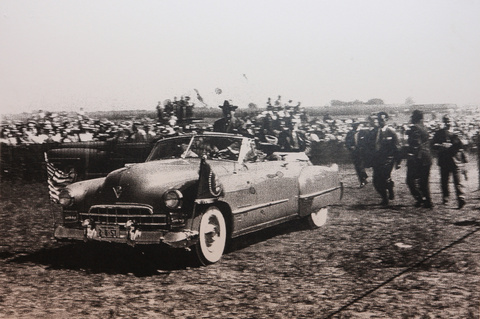
WhenTruman arrived in Dexter on Sept. 18, 1948, he was a 50-to-1 underdog against his presidential rival, New York Governor Thomas Dewey. Nevertheless, a crowd welcomed Truman to Dexter, Iowa, in grand style. As part of his whistle-stop presidential campaign, Truman arrived in Dexter via the Rock Island Railroad, where he was greeted at the depot by the Dexter school band, a parade and a queen and her court. The president, his wife, Bess, and their daughter, Margaret, were escorted to the farm site north of Dexter by a motorcade that included Truman’s convertible limousine.
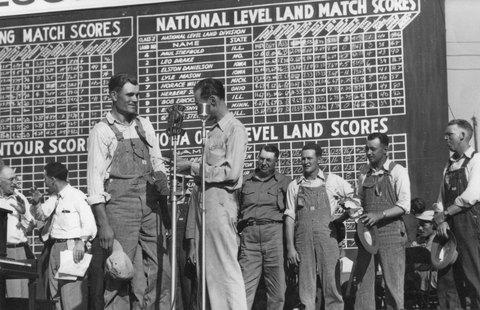
Donald Hanson (left of the radio microphone), a farmer from Roland and competitor at the 1948 National Plowing Matches near Dexter, Iowa, was interviewed on WHO Radio. Hanson is the grandfather of Eric Hanson, a television reporter and anchor on KCCI in Des Moines.
Truman came to Iowa to “Give ‘em Hell”
When Truman arrived in Dexter on Sept. 18, 1948, he was a 50-to-1 underdog against his presidential rival, New York Governor Thomas Dewey. Truman’s appearance in Dallas County stemmed from a White House visit months before when Iowa Farm Bureau President E. Howard Hill and other Iowa ag leaders met with Truman in May 1948 and invited him to come to the National Soil Conservation Field Days and Plowing Matches. The president tried to discourage the men, asserting that they’d have nothing but problems if he and his entourage came.
Dewey was also invited to attend the event but turned the Iowans down flat. “Dewey thought he had the election locked up,” Larson said. “The Midwest didn’t like Dewey, because he was an elitist who had no time for Iowa dirt farmers.”
Months went by with no word from the White House. Then three weeks before the big day, plowing match organizers were notified that Truman had accepted their invitation. Once Dewey heard Truman was headed to Iowa, he immediately arranged for a farm-press event to be held on his Pawling, N.Y., farm on the same day as the national plowing matches near Dexter.
While the media focused on New York, all roads led to the nation’s largest farm event in central Iowa on the September 18, 1948. As the sun rose and the mercury soared, bumper-to-bumper traffic soon clogged the roads near Dexter.
The crowd welcomed Truman in grand style. As part of his whistle-stop presidential campaign, Truman arrived in Dexter via the Rock Island Railroad, where he was greeted at the depot by the Dexter school band, a parade and a queen and her court. The president, his wife, Bess, and their daughter, Margaret, were escorted to the farm site north of Dexter by a motorcade that included Truman’s convertible limousine.
Much to Truman’s delight, a huge crowd of 100,000 people gathered on Lois Agg’s farm to watch the plowing matches, see new conservation practices in action and hear him deliver a speech about farm policy.
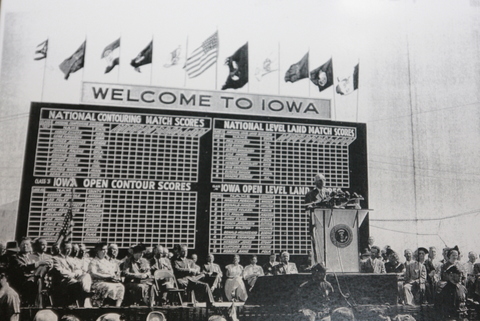
President Harry Truman spoke about farm policy before a crowd of 100,000 people on Sept. 18, 1948, near Dexter, Iowa. This was the first speech that was referred to as “Give ‘Em Hell, Harry,” a slogan that stuck with Truman for the rest of the campaign.
WHO Radio personality Herb Plambeck introduced Truman. During Truman’s 29-minute speech, which was the first major speech of his 1948 presidential campaign, he was interrupted by applause 13 times. The loudest cheers came when he referred to the 80th Congress as the “do nothing Congress.” This was the first speech that was referred to as “Give ‘Em Hell, Harry,” a slogan that stuck with Truman for the rest of the campaign.
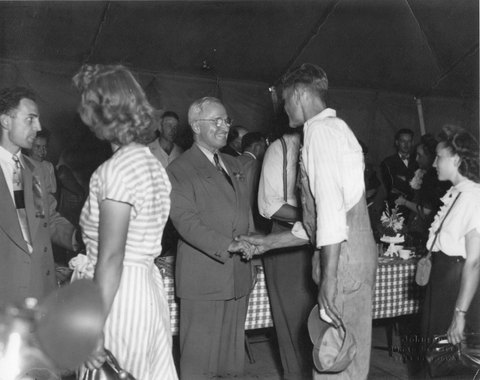
President Harry Truman greeted the crowd at the 1948 National Soil Conservation Field Days and Plowing Matches in Dallas County.
Event ushered in the modern era of ag conservation
After the speech, Truman and his entourage dined on fried chicken before heading out to the demonstration sites to see terraces, ponds and other conservation practices. Truman jumped off the hayrack to get a closer look, as members of the Secret Service scrambled to catch up with him.
“Truman was very interested in soil conservation and asked us a lot of questions,” Larson said. “While some guys thought terraces and contour farming were crazy, many farmers were intrigued by new conservation practices that were being promoted by the Soil Conservation Service.”
Truman took off his suit jacket, rolled up his sleeves on that hot afternoon and continued asking questions as he rode on Larson’s bulldozer while the Secret Service looked on. Larson wasn’t nervous as he chauffeured the president. “Truman was just an old farmer who wanted to know practical things, like how much dirt I was hauling.”
The response Truman received in Dexter that day revitalized his presidential campaign and Truman himself. While the polls still had Truman trailing Dewey on the eve of the 1948 election, and his margin of victory was small, Truman went on to become the 33rd president of the United States.
Truman’s appearance at Dexter also helped usher in the modern era of conservation in agriculture. Larson’s conservation work left a lasting impact, as well, since the dam and pond he built in 1948 are still there. His story, along with photos from that unforgettable day, are preserved at the Dexter Museum and on a historical marker north of Dexter.
“Truman made a good impression on me,” Larson said. “If I’d been old enough to vote in 1948, I probably would have picked Truman.”
Explore more rural Iowa history
Want to discover more stories and pictures that showcase the unique history of small-town and rural Iowa? Check out my top-selling “Calhoun County” book from Arcadia Publishing, and order your signed copy today.
P.S. Thanks for joining me. I’m glad you’re here.
@Copyright 2016 Darcy Maulsby & Co.

